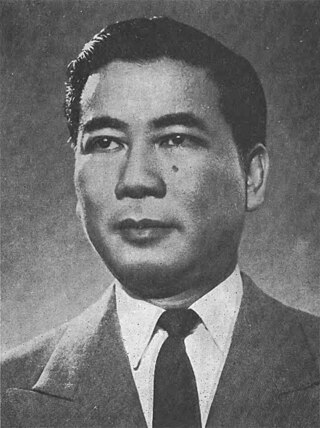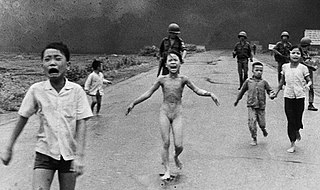
Ngô Đình Diệm was a South Vietnamese politician who was the final prime minister of the State of Vietnam (1954–1955) and later the first president of South Vietnam from 1955 until his capture and assassination during the CIA-backed 1963 South Vietnamese coup.

South Vietnam, officially the Republic of Vietnam, was a country in Southeast Asia that existed from 1955 to 1975, the period when the southern portion of Vietnam was a member of the Western Bloc during part of the Cold War after the 1954 division of Vietnam. It first received international recognition in 1949 as the State of Vietnam within the French Union, with its capital at Saigon, before becoming a republic in 1955. South Vietnam was bordered by North Vietnam to the north, Laos to the northwest, Cambodia to the southwest, and Thailand across the Gulf of Thailand to the southwest. Its sovereignty was recognized by the United States and 87 other nations, though it failed to gain admission into the United Nations as a result of a Soviet veto in 1957. It was succeeded by the Republic of South Vietnam in 1975. In 1976, the Republic of South Vietnam and North Vietnam merged to form the Socialist Republic of Vietnam.

The Viet Cong was an epithet to call the communist movement and united front organization in South Vietnam, Laos and Cambodia. Formally organized as and led by the National Liberation Front of South Vietnam, it fought under the direction of North Vietnam against the South Vietnamese and United States governments during the Vietnam War. The organization had both guerrilla and regular army units, as well as a network of cadres who organized and mobilized peasants in the territory the Viet Cong controlled. During the war, communist fighters and some anti-war activists claimed that the Viet Cong was an insurgency indigenous to the South, while the U.S. and South Vietnamese governments portrayed the group as a tool of North Vietnam. According to Trần Văn Trà, the Viet Cong's top commander, and the post-war Vietnamese government's official history, the Viet Cong followed orders from Hanoi and were practically part of the People's Army of Vietnam, or North Vietnamese army.

David Halberstam was an American writer, journalist, and historian, known for his work on the Vietnam War, politics, history, the Civil Rights Movement, business, media, American culture, Korean War, and later, sports journalism. He won a Pulitzer Prize for International Reporting in 1964. Halberstam was killed in a car crash in 2007, while doing research for a book.

Phan Thị Kim Phúc, referred to informally as the girl in the picture and the napalm girl, is a South Vietnamese-born Canadian woman best known as the nine-year-old child depicted in the Pulitzer Prize–winning photograph, titled "The Terror of War", taken at Trảng Bàng during the Vietnam War on June 8, 1972.
Cornelius Mahoney Sheehan was an American journalist. As a reporter for The New York Times in 1971, Sheehan obtained the classified Pentagon Papers from Daniel Ellsberg. His series of articles revealed a secret United States Department of Defense history of the Vietnam War and led to a U.S. Supreme Court case, New York Times Co. v. United States, 403 U.S. 713 (1971), which invalidated the United States government's use of a restraining order to halt publication.

Huỳnh Công Út, known professionally as Nick Ut, is a Vietnamese-American photographer who worked for the Associated Press (AP) in Los Angeles. He won both the 1973 Pulitzer Prize for Spot News Photography and the 1973 World Press Photo of the Year for "The Terror of War", depicting children running away from a napalm bombing attack during the Vietnam War.
Land reform in South Vietnam refers to reforms proposed by the United States and implemented by South Vietnam. Seeking to undermine the popularity of the communist Việt Minh's policies of land redistribution to poor peasants, the government of South Vietnam implemented their own land-redistribution policies during the Vietnam War.

Frances FitzGerald is an American journalist and historian, who is primarily known for Fire in the Lake: The Vietnamese and the Americans in Vietnam (1972), an account of the Vietnam War. It was a bestseller that won the Pulitzer Prize, Bancroft Prize, and National Book Award.

David Hume Kennerly is an American photographer. He won the 1972 Pulitzer Prize for Feature Photography for his portfolio of photographs of the Vietnam War, Cambodia, East Pakistani refugees near Calcutta, and the Ali-Frazier fight in Madison Square Garden. He has photographed every American president since Lyndon B Johnson. He is the first presidential scholar at the University of Arizona.
Desmond FitzGerald was an American intelligence officer for the Central Intelligence Agency (CIA), where he rose to the position of Deputy Director of Plans. He served in the CIA from 1950 until his death. Posthumously he was awarded the National Security Medal. An attorney, he had worked in New York City both before and after World War II. During the war, he was an Army officer, serving as liaison and adviser to the Chinese Army.
The following are the Pulitzer Prizes for 1973.
United States involvement in the Vietnam War began shortly after the end of World War II in Asia, first in an extremely limited capacity and escalating over a period of 20 years. The U.S. military presence peaked in April 1969, with 543,000 American combat troops stationed in Vietnam. By the conclusion of the United States's involvement in 1973, over 3.1 million Americans had been stationed in Vietnam.

The Double Seven Day Scuffle was a physical altercation on July 7, 1963, in Saigon, South Vietnam. The secret police of Ngô Đình Nhu—the brother of President Ngô Đình Diệm—attacked a group of US journalists who were covering protests held by Buddhists on the ninth anniversary of Diệm's rise to power. Peter Arnett of the Associated Press (AP) was punched on the nose, and the quarrel quickly ended after David Halberstam of The New York Times, being much taller than Nhu's men, counterattacked and caused the secret police to retreat. Arnett and his colleague, the Pulitzer Prize-winning journalist and photographer Malcolm Browne, were later accosted by policemen at their office and taken away for questioning on suspicion of attacking policemen.

Malcolm Wilde Browne was an American journalist and photographer, best known for his award-winning photograph of the self-immolation of Buddhist monk Thích Quảng Đức in 1963.
Children of Crisis is a social study of children in the United States written by child psychiatrist Robert Coles and published in five volumes by Little, Brown and Company between 1967 and 1977. In 2003, the publisher released a one-volume compilation of selections from the series with a new introduction by the author. Volumes 2 and 3 shared the 1973 Pulitzer Prize for General Non-Fiction.

Tôn Thất Thiện (1924–2014) was a South Vietnamese nationalist of the post-World War II generation who had the rare distinction of serving and watching at close quarters the two historic leaders of post-World War II Vietnam: presidents Ho Chi Minh in the Viet Minh coalition in 1945–46, and Ngô Đình Diệm 1954–55/1956–59/1963. He played a significant though understated role in the nationalist attempt to preserve a non-Communist Vietnam.

Tran Ngoc Châu was a Vietnamese soldier, civil administrator, politician, and later political prisoner, in the Republic of Vietnam until its demise with the Fall of Saigon in 1975. There are published photographs of Châu taken c.1952 and 1969, and others in his memoirs, Vietnam Labyrinth.
The United Front for the Liberation of Oppressed Races waged a nearly three decade long insurgency against the governments of North and South Vietnam, and later the unified Socialist Republic of Vietnam. The FULRO insurgents represented the interests of indigenous Muslim and Hindu Cham, Montagnards, and Buddhist Khmer Krom against the ethnic Kinh Vietnamese. They were supported and equipped by China and Cambodia according to those countries' interests in the Indochina Wars.
Street without Joy is a 1961 book about the First Indochina War (1946–1954); it was revised in 1964. The author Bernard B. Fall was a French-American professor and journalist. He had been on-site as a French soldier, and then as an American war correspondent. The book gives a first-hand look at the French engagement, with an insider understanding of Vietnamese events, and provided insights into guerrilla warfare. It drew wide interest among Americans in the mid-1960s, when their own country markedly increased its activity in the Vietnam War.












